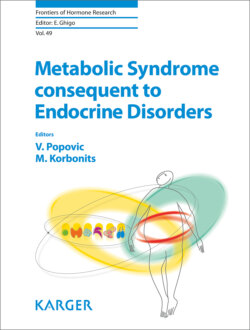Читать книгу Metabolic Syndrome Consequent to Endocrine Disorders - Группа авторов - Страница 13
Clinical Relevance of Metabolic Phenotype in Hypopituitarism
ОглавлениеHypopituitarism removes the natural survival advantage that women have over men. Highest mortality is among younger patients, women, and patients with diabetes insipidus [10–12]. Most common causes of death in patients with hypopituitarism are cardiovascular and cerebrovascular designated to the associated MetS and treatment modalities such as cranial irradiation. Conventional sequential radiotherapy was reported to be associated with post irradiation vasculopathy and an increased risk of cerebrovascular complications in previous studies [10, 14]. Weather the cranial irradiation affects central regulation of metabolism, which could in theory independently of hypopituitarism affect the metabolic profile of these patients, is currently unexplored. Transcranial surgery, etiology (caniopharyngeoma, aggressive pituitary adenoma), and presence of diabetes insipidus are also associated with more extensive, aggressive disease and increased mortality [10–13].
After the first data on excess mortality from cardio-vascular causes in adult patients with hypopituitarism, receiving conventional replacement without GH therapy, clinical efforts were made to define and replace GH deficiency (GHD) in adults as the major cause of MetS phenotype and increased vascular risk in these patients. Studies that followed, reported cardio-vascular mortality rates, for patients with GHD treated with GH, that were similar to the background population suggesting amelioration with GH replacement [14]. GH replacement appeared to provide protection from myocardial infarction [14]. Data on cerebrovascular events during 5 years of GH replacement showed persistence of increased mortality rates [14]. Adult patients with craniopharyngeoma (more obese with more severe MetS and pituitary deficiencies, including diabetes insipidus) seemed to respond equally well to GH treatment as patients with non-functioning pituitary adenoma (NFPA), but were less likely to lose body fat [15]. Despite improvement in lipid profiles and body composition parameters during GH replacement, several studies reported no change in the prevalence of MetS after 2–5 years of treatment [2, 4, 16]. An increase in the prevalence of MetS after 10 years of low-dose GH replacement due to steady increase in BMI, waist circumference, and BP, despite improvement in lipid profile, was reported recently [7]. The increase in the MetS prevalence was higher than expected with aging alone [7]. Furthermore, data regarding the prevalence of diabetes mellitus in GH treated versus untreated patients with adult-onset of hypopituitarism are still lacking. Results of safety surveillance studies from large databases during the long term follow-up are controversial reporting improvement, neutral or even unfavorable effects on glucose metabolism and tolerance with increased incidence of diabetes in female patients and hypopituitary patients with MetS [5, 6, 16].
Up to now, few studies have focused on the impact of other replacement therapies with glucocorticoids (GC), thyroxin (T4), and sex steroids on features of the MetS and mortality rates in patients with hypopituitarism [17–19]. It has been suggested that some hormone replacement regimes, such as overzealous replacement with hydrocortisone (HC), T4 under-replacement, unreplaced hypogonadism, or the use of oral contraceptives for replacement of female patients during GH therapy, may also contribute to adverse outcomes and MetS phenotype in patients with hypopituitarism [16–25].
